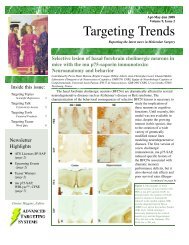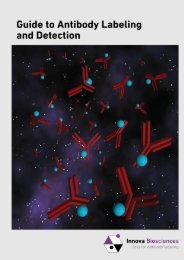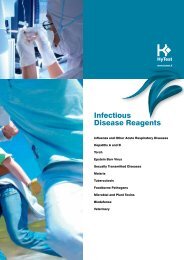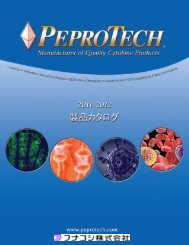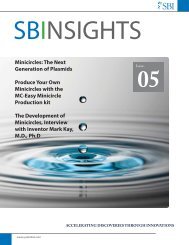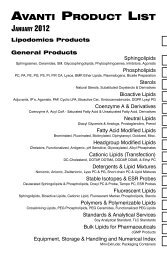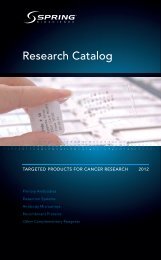PhiCal®Calprotectin ELISA Kit PhiCal®Calprotectin ELISA Kit
PhiCal®Calprotectin ELISA Kit PhiCal®Calprotectin ELISA Kit
PhiCal®Calprotectin ELISA Kit PhiCal®Calprotectin ELISA Kit
You also want an ePaper? Increase the reach of your titles
YUMPU automatically turns print PDFs into web optimized ePapers that Google loves.
Arbeitsanleitung / Manual PhiCal® Calprotectin (MRP 8/14)Inhalt1. VERWENDUNGSZWECK________________________________________22. EINLEITUNG_________________________________________________23. INHALT DER TESTPACKUNG_ ___________________________________34. ERFORDERLICHE LABORGERÄTE UND HILFSMITTEL_ ______________45. VORBEREITUNG UND LAGERUNG DER REAGENZIEN_ ______________46. PROBENVORBEREITUNG_______________________________________5Stuhlprobenextraktion_________________________________________________ 5Probenverdünnung___________________________________________________ 67. TESTDURCHFÜHRUNG________________________________________7Testprinzip_ _________________________________________________________ 7Pipettierschema_ _____________________________________________________ 78. ERGEBNISSE_ ________________________________________________89. EINSCHRÄNKUNGEN_ _________________________________________910. QUALITÄTSKONTROLLE_______________________________________9Erwartete Ergebnisse_ _________________________________________________ 911. TESTCHARAKTERISTIKA_ ____________________________________ 10Präzision und Reproduzierbarkeit________________________________________ 10Wiederfindung_ _____________________________________________________ 10Analytische Sensitivität_______________________________________________ 11Kreuzreaktivität_ ____________________________________________________ 11Linearität_ _________________________________________________________ 1112. VORSICHTSMASSNAHMEN___________________________________ 1213. TECHNISCHE MERKMALE_ ___________________________________ 1214. ALLGEMEINE HINWEISE ZUM TEST_ ___________________________ 1215. LITERATUR_________________________________________________ 131
Arbeitsanleitung / Manual PhiCal® Calprotectin (MRP 8/14)1. VERWENDUNGSZWECKDer hier beschriebene Enzyme-Linked-Immuno-Sorbent-Assay (<strong>ELISA</strong>) ist für die quantitativeBestimmung von PhiCal® Calprotectin (MRP 8/14) in Stuhl geeignet. Nur zur in vitro Diagnostik.2. EINLEITUNGAlternative Namen:Calgranulin A: MRP8, S100A8, CP-10 (in Maus)Calgranulin B: MRP14, S100A9,MRP8/14: L1, (p8,14), p34Calprotectin ist ein Calcium-bindendes Protein, das von Neutrophilen und Monozytengebildet wird. Fäkales Calprotectin ist ein Marker für gastrointestinale Erkrankungen entzündlicherund neoplastischer Genese.Die Unterscheidung zwischen Patienten mit Colon irritabel und solchen mit chronischentzündlichenDarmerkrankungen (CED) fällt häufig schwer. Dies führt zu vielen nicht notwendigenKoloskopien. Mittels des Calprotectin-Tests können diese beiden Patientengruppenjetzt deutlich voneinander unterschieden werden. Der Nachweis aus dem Stuhl korreliertsehr gut mit den histologischen und endoskopischen Befunden der Krankheitsaktivität beiMorbus Crohn und Colitis ulcerosa, sowie mit dem bisherigen „Gold-Standard“ für die Aktivitätsbeurteilungbei CED, der Messung der fäkalen Exkretion 111-Indium-markierter neutrophilerGranulozyten. Der Indium–111-Granulozytentest ist jedoch kostenintensiv (Krankenhausaufenthalt,Isotopenbestimmung und Entsorgung) und durch die Radioaktivität belastend fürdie Patienten. Eine wiederholte Anwendung bei Kindern und Schwangeren ist daher nichtempfehlenswert.Im Gegensatz zu den bisherigen Standardmarkern für entzündliche Vorgänge (CRP, ESR, HB)zeigen erhöhte Calprotectin-Werte mit größerer Sicherheit ein Rezidiv an. Calprotectin ist damitein idealer Verlaufsmarker, z.B. bei M. Crohn oder nach Polypenabtragung. VergleichendeMessungen von Calprotectin und okkultem Blut zum Nachweis des Kolonkarzinoms ergabeneinen eindeutigen diagnostischen Vorteil für Calprotectin. Der Parameter hat eine hohe negativeprädiktive Aussagekraft: Ist der Calprotectin-Spiegel im Stuhl niedrig, liegt mit hoherWahrscheinlichkeit keine organische Erkrankung des Intestinaltrakts vor.2
Arbeitsanleitung / Manual PhiCal® Calprotectin (MRP 8/14)IndikationenEntzündungsmarker für akute entzündliche ErkrankungenBewertung des Schweregrads einer EntzündungVerlaufsparameter bei M. Crohn, Colitis ulcerosa oder nach PolypenabtragungSichere Differenzierung zwischen einer organischen Erkrankung des Intestinaltrakts(chronisch-entzündliche Darmerkrankungen, infektiöse Erkrankungen, Polypen,Kolonkarzinom) und einer funktionellen Erkrankung (Reizdarmsyndrom)3. INHALT DER TESTPACKUNGArtikel Nr. Inhalt <strong>Kit</strong> Komponenten MengeK 6927MTP PLATE Mikrotitermodul, vorbeschichtet12 x 8VertiefungenK 6927WP WASHBUF <strong>ELISA</strong> Waschpufferkonzentrat 10x 2 x 100 mlK 6927EP EXBUF Extraktionspufferkonzentrat 2,5x 2 x 90 mlK 6927PVSAMPLEBUFProbenverdünnungsspuffer,gebrauchsfertig1 x 100 mlK 6927STSTDCalprotectin Standards, lyophilisiert(0; 13; 52; 210; 840 ng/ml)2 x 5 vialsK 6927KO1CTRLKontrolle, lyophilisiert(Bereich der Spezifikation entnehmen)2 x 1 vialK 6927KO2CTRLKontrolle, lyophilisiert(Bereich der Spezifikation entnehmen)2 x 1 vialK 6927K CONJ Konjugat, gebrauchsfertig 15 mlK 6927TMBSUBTMB Substrat (Tetramethylbenzidin),gebrauchsfertig15 mlK 6927AC STOP <strong>ELISA</strong> Stopplösung, gebrauchsfertig 15 ml3
Arbeitsanleitung / Manual PhiCal® Calprotectin (MRP 8/14)4. ERFORDERLICHE LABORGERÄTE UND HILFSMITTEL Reinstwasser* Laborwaage Präzisionspipetten und Pipettenspitzen für den Einmalgebrauch mit variablenVolumina von 10–1000 µl Folie zum Abkleben der Mikrotiterplatte Multikanal- bzw. Multipipette Zentrifuge, 3000 x g Vortex-Mixer Laborübliche Glas- oder Plastikröhrchen (Einmalartikel) Mikrotiterplattenphotometer mit Filter 450 nm* Immundiagnostik AG empfiehlt die Verwendung von Reinstwasser nach ISO 3696. Eshandelt sich dabei um Wasser des Typs 1, welches frei von ungelösten und kolloidalenIonen und organischen Molekülen ist (frei von Partikeln > 0,2 µm) mit einerelektrischen Leitfähigkeit < 0,055 µS/cm bei 25°C (≥18,2 MΩ cm).5. VORBEREITUNG UND LAGERUNG DER REAGENZIEN Bitte achten Sie bei mehrfachem Einsatz der Platte darauf, dass die Reagenzien, wie inder Vorschrift beschrieben, gelagert und nur die für den jeweiligen Ansatz benötigtenReagenzienmengen frisch angesetzt werden. Der <strong>Kit</strong> kann so bis zu 4 x je nachProbenaufkommen bis zum angegebenen Haltbarkeitsdatum verwendet werden. Reagenzien mit einem Volumen kleiner 100 µl sollten vor Gebrauch zentrifugiertwerden, um Volumenverluste zu vermeiden. Der WASHBUF (Waschpufferkonzentrat) muss vor Gebrauch 1:10 in Reinstwasser verdünntwerden (100 ml WASHBUF + 900 ml Reinstwasser), gut mischen. Aufgrund derhohen Salzkonzentration in den Stammlösungen kann es zu Kristallbildungen kommen.Die Kristalle lösen sich im Wasserbad bei 37 °C auf. Das Pufferkonzentrat kannbei 2-8 °C bis zum angegebenen Haltbarkeitsdatum aufbewahrt werden. Die verdünntePufferlösung (Waschpuffer) ist bei 2-8 °C einen Monat in einem geschlossenenGefäß haltbar.4
Arbeitsanleitung / Manual PhiCal® Calprotectin (MRP 8/14)c) Röhrchen aufschrauben (gelbes Gewinde), der untere Teil des Stäbchens weist Einkerbungenauf, welche durch Einstechen in die Stuhlprobe vollkommen mit Probebedeckt werden müssen. Anschließend das Stäbchen durch den Abstreifring zurückins Röhrchen stecken (leichter Widerstand) und fest verschrauben.d) Das Röhrchen solange mischen bis keine Stuhlreste mehr in den Einkerbungenauszumachen sind. Für die Erhebung valider Messwerte ist darauf zu achten, dassdie Stuhlsuspension nach dem Mischungsprozess eine möglichst homogene Konsistenzaufweist. Bei besonders festen Stühlen kann die Homogenität der Suspensiondurch längeres „einweichen“ (ca. 10 min) des Stuhls in Extraktionspuffer bedeutendgesteigert werden.e) Nach erfolgter Suspendierung der Probe wird das Röhrchen ca. 10 Minuten stehengelassen. Aufschwimmende Schalen von Körnern u. Ä. können hierbei vernachlässigtwerden.f) Anschließend wird der gesamte Kopf des Stuhlröhrchens (türkiser Ring) zusammenmit dem Stäbchen vorsichtig abgeschraubt und verworfen. Bei dem Abschraubendes Kopfes ist darauf zu achten, dass das abgesetzte Sediment nicht erneut aufgewirbeltwird.1b. Probenvorbereitungssystem der Fa. Roche Diagnostics, Mannheim (Best. Nr. 10745 804 322)Alternativ kann ein anderes Stuhlaufarbeitungssystem (z. B. Proben-vorbereitungssystemder Fa. Roche Diagnostics, Mannheim) verwendet werden. Bei dem RocheProbenvorbereitungssystem werden 100 mg Stuhlprobe in 5 ml Extraktionspuffermit Hilfe eines Vibrationsmischers (z. B. Vortex) homogenisiert. Anschließendes Zentrifugierenwird empfohlen.Verdünnung I (1a. oder 1b.): 1:50Probenverdünnung6StuhlprobenDie Suspension aus Probenvorbereitung 1a. bzw. 1b. (Verdünnung I) wird 1:50 mitSAMPLEBUF (Probenverdünnungsspuffer) verdünnt. Zum Beispiel:20 µl Überstand (Verdünnung I) + 980 µl SAMPLEBUF = 1:50 (Verdünnung II)100 µl der Verdünnung II im Test pro Vertiefung einsetzen.Laut Literatur ist Calprotectin im Stuhl bis zu 6 Tagen stabil. Trotzdem empfehlen wir dieProbe nicht länger als 48 Stunden bei 2–8 °C zu lagern. Bei längeren Aufbewahrungszeitensind die Proben bei -20 °C zu lagern. Gefrorene Proben über Nacht bei 2–8 °C auftauenund am besten vor der Analyse auf Raumtemperatur bringen.(Poullis A et al. (2002) Aliment Pharmacol Thr 16:675-681)
Arbeitsanleitung / Manual PhiCal® Calprotectin (MRP 8/14)3. Gewichtete Spline-FunktionFür die optische Dichte empfehlen wir eine lineare Ordinate und für die Konzentrationeine logarithmische Abszisse (bei einer logarithmischen Abszisse muss für denStandard mit der Konzentration 0 ein Wert kleiner 1 eingegeben werden z. B. 0.001).Vor jeder automatischen Auswertung sollte stets eine Kontrolle der Doppelwerteauf Plausibilität („Ausreißerkontrolle“) durchgeführt werden; falls dies nicht durchdas verwendete Programm erfolgt, sollte die Kontrolle manuell durchgeführt werden.StuhlprobenDer ermittelte Calprotectin-Wert der Stuhlprobe wird mit 2500 multipliziert (VerdünnungI x Verdünnung II).9. EINSCHRÄNKUNGENStuhlproben mit hohen Calprotectin Konzentrationen, die außerhalb der Standardkurveliegen, werden mit SAMPLEBUF (Probenverdünnungsspuffer) verdünnt und nochmalsbestimmt.10. QUALITÄTSKONTROLLEWir empfehlen Kontrollen bei jedem Testansatz mitzumessen. Die Ergebnisse der Kontrollenmüssen auf Richtigkeit überprüft werden. Liegen einer oder mehrere Werte außerhalbdes angegebenen Bereichs, kann Immundiagnostik AG die Richtigkeit der Wertenicht gewährleisten.Erwartete ErgebnisseNormwerte1g Stuhl entspricht 1ml Der Medianwert von augenscheinlich gesunden Personen beträgt ca. 25 mg/kg. Proben mit Werten von mehr als 50 mg/kg werden als positiv betrachtet.Wir empfehlen jedem Labor einen eigenen Normwertbereich zu etablieren.9
Arbeitsanleitung / Manual PhiCal® Calprotectin (MRP 8/14)Analytische SensitivitätDie Nachweisgrenze wurde als B0 + 6*SD festgelegt. Gemessen wurde 22 mal derStandard null.ProbeCalprotectinMittelwert [OD]Standardabweichung[SD]Nachweisgrenze[ng/ml]1 0,021 0,00188 2,099* Bei Berücksichtigung der Stuhlprobenverdünnung von 1 : 2500 entspricht einer Konzentration von 5,2475 mg/L.KreuzreaktivitätEs wurde keine Kreuzreaktivität zu folgenden Plasmaproteinen gefunden:Lysozym - 0%PMN-Elastase - 0%Myeloperoxidase - 0%Laktoferrin - 0%LinearitätZwei Patientenproben wurden mit Waschpuffer verdünnt und im Test gemessen. DieErgebnisse sind in der unten stehenden Tabelle aufgeführt.n= 2ProbeVerdünnungErwartet[ng/ml]Gemessen[ng/ml]2500 120 120A5000 60 61,810000 30 32,42500 116 116B5000 58 59,410000 29 28,911
Arbeitsanleitung / Manual PhiCal® Calprotectin (MRP 8/14) Die charakteristischen Testdaten wie Inkubationszeiten, Inkubationstemperaturenund Pipettiervolumina der verschiedenen Komponenten wurden firmenintern festgelegt.Nicht mit dem Hersteller abgesprochene Veränderungen in der Testdurchführungkönnen die Resultate beeinflussen. Die Firma Immundiagnostik AG übernimmtfür die hierdurch entstandenen Schäden und Folgeschäden keine Haftung. Bei Gewährleistungsansprüchen ist das beanstandete Material mit schriftlicherErklärung innerhalb von 14 Tagen zum Hersteller - der Immundiagnostik AG zurück zusenden.15. LITERATUR1. Poullis A et al. (2002) Aliment Pharmacol Thr 16:675-6812. Fagerhol et al. (2000) The Lancet 356:1783-17843. Tibble et al. (2000) Gut 47:506-5134. Tibble et al. (2000) Gastro 119:15-22Publikationen mit dem Immundiagnostik Calprotectin-<strong>ELISA</strong>:1. Langhorst J, Koelzer J, Elsenbruch S, Rueffer A, Michalsen A, Dobos GJ (2007) Non-invasiveMarker der Entzündungsaktivität bei Patienten mit chronisch entzündlichenDarmerkrankungen (CED): Vergleich von Lactoferrin, Calprotectin, PMN-Elastase imStuhl, Serum-CRP und klinischen Aktivitätsindizes. Z Gastroenterol 45: P2612. Schröder O, Naumann M, Shastri Y, Povse N, Stein J (2007) Prospective evaluation offaecal neutrophil-derived proteins in identifying intestinal inflammation: combinationof parameters does not improve diagnostic accuracy of calprotectin. AlimentPharmacol Ther Oct 1;26(7):1035-423. Shastri YM , Bergis D, Schäfer V, Povse N, Stein J (2006) Prospective Muliticentre doubleblind randomized controlled trial for predicting microbiological stool culturepositivity for acute diarrhea. Poster presented at Conference of Indian Society of Gastroenterology,November 7-12, 2006, Mumbai13
Arbeitsanleitung / Manual PhiCal® Calprotectin (MRP 8/14)Verwendete Symbole:TemperaturbegrenzungBestellnummerIn-Vitro-DiagnostikumInhalt ausreichend für PrüfungenHerstellerVerwendbar bisChargenbezeichnung14
ManualPhiCal® Calprotectin <strong>ELISA</strong> <strong>Kit</strong>For the in vitro determination of PhiCal® Calprotectin(MRP 8/14) in stoolValid from 17.01.2012K 6927[PhiCal®: registered German trademark of Immundiagnostik AG][Not sold in the USA]
Arbeitsanleitung / Manual PhiCal® Calprotectin (MRP 8/14)Content1. INTENDED USE_ ____________________________________________ 172. INTRODUCTION ____________________________________________ 173. MATERIAL SUPPLIED_ _______________________________________ 184. MATERIAL REQUIRED BUT NOT SUPPLIED ______________________ 185. PREPARATION AND STORAGE OF REAGENTS____________________ 196. SAMPLE PREPARATION ______________________________________ 20Extraction of the stool sample__________________________________________ 20Dilution of samples___________________________________________________ 217. ASSAY PROCEDURE _________________________________________ 21Principle of the test___________________________________________________ 21Test procedure______________________________________________________ 228. RESULTS___________________________________________________ 239. LIMITATIONS_______________________________________________ 2310. QUALITY CONTROL_ ________________________________________ 23Expected values_ ____________________________________________________ 23Precision and reproducibility_ __________________________________________ 24Recovery___________________________________________________________ 24Analytical Sensitivity_________________________________________________ 25Linearity_ __________________________________________________________ 25Cross-reactivity______________________________________________________ 2512. PRECAUTIONS______________________________________________ 2613. TECHNICAL HINTS_ _________________________________________ 2614. GENERAL NOTES ON THE TEST AND TEST PROCEDURE_ __________ 2615. REFERENCES_ ______________________________________________ 2716
Arbeitsanleitung / Manual PhiCal® Calprotectin (MRP 8/14)1. INTENDED USEThe described Enzyme-Linked-Immuno-Sorbent-Assay (<strong>ELISA</strong>) <strong>Kit</strong> is intended for the quantitativedetermination of PhiCal® Calprotectin (MRP (8/14) in stool. It is for in vitro diagnosticuse only.2. INTRODUCTIONAlternative names:Calgranulin A: MRP8, S100A8, CP-10 (in mouse)Calgranulin B: MRP14, S100A9,MRP8/14: L1, (p8,14), p34Calprotectin is a calcium-binding protein secreted predominantly by neutrophils and monocytes.Fecal Calprotectin is a marker for neoplasic and inflammatory gastrointestinal diseases.It is often difficult to distinguish between irritable bowel syndrome and chronic inflammatorybowel disease. This leads in many cases to extensive and unnecessary colonoscopicexaminations. The Calprotectin test allows clear differentiation between the two patientgroups. Fecal Calprotectin levels correlate significantly with histologic and endoscopic assessmentof disease activity in Morbus Crohn‘s disease and ulcerative colitis as well as with thefecal excretion of indium-111-labelled neutrophilic granulocytes that has been suggested asthe “gold standard“ of disease activity in inflammatory bowel disease. However, measuring111-indium-labeled granulocytes is very costly (patient’s hospitalization, analysis and disposalof isotopic material) and is connected with radioactive exposition of the patients. For thisreason, a repeated application to children and pregnant women is not recommended.Elevated levels of Calprotectin are a much better predictor of relapse than standard inflammatorymarkers (CRP, ESR HB). Comparing this marker with standard fecal occult blood screeningin colorectal cancer demonstrates clearly the diagnostic advantages of the fecal Calprotectintest. The parameter is of a high diagnostic value: if the Calprotectin level in stool is low, theprobability is high that no organic intestinal disease exists.Indications Marker for acute inflammation Estimation of gastrointestinal inflammation degree Parameter for monitoring Morbus Crohn‘s disease, Colitis ulcerosa or the patient‘s statusafter removal of polyps. Discrimination between patients with inflammatory bowel disease (acute MorbusCrohn‘s disease and ulcerative colitis) and irritable bowel syndrome when using a fecaltest system17
Arbeitsanleitung / Manual PhiCal® Calprotectin (MRP 8/14)3. MATERIAL SUPPLIEDCat. No Content <strong>Kit</strong> Components QuantityK 6927MTP PLATE One holder with precoated strips 12 x 8 wellsK 6927WP WASHBUF <strong>ELISA</strong> wash buffer concentrate 10x 2 x 100 mlK 6927EP EXBUF Extraction buffer concentrate 2.5x 2 x 90 mlK 6927PVSAMPLEBUFSample dilution buffer,ready to use1 x 100 mlK 6927STSTDCalprotectin standards, lyophilized(0; 13; 52; 210; 840 ng/ml)2 x 5 vialsK 6927KO1CTRLControl, lyophilized(see specification for range)2 x 1 vialK 6927KO2CTRLControl, lyophilized(see specification for range)2 x 1 vialK 6927K CONJ Conjugate, ready to use 15 mlK 6927TMBSUBTMB substrate (Tetramethylbenzidine),ready to use15 mlK 6927AC STOP <strong>ELISA</strong> stop solution, ready to use 15 ml4. MATERIAL REQUIRED BUT NOT SUPPLIED Ultra pure water* Laboratory balance Precision pipettors calibrated and tips to deliver 10-1000 µl Covering foil for the microtiter plater A multi-channel dispenser or repeating dispenser Centrifuge capable of 3000 x g Vortex-Mixer Standard laboratory glass or plastic vials, cups, etc. Microtiter plate reader at 450 nm18* Immundiagnostik AG recommends the use of Ultra Pure Water (Water Type 1; ISO3696), which is free of undissolved and colloidal ions and organic molecules (free ofparticles > 0.2 µm) with an electrical conductivity < 0.055 µS/cm at 25°C (≥18.2 MΩcm).
Arbeitsanleitung / Manual PhiCal® Calprotectin (MRP 8/14)5. PREPARATION AND STORAGE OF REAGENTS To run assay more than once, ensure that reagents are stored at the conditions statedon the label. Prepare only the appropriate amount necessary for each assay. Thekit can be used up to 4 times within the expiry date stated on the label. Reagents with a volume less than 100 µl should be centrifuged before use to avoidloss of volume. The <strong>ELISA</strong> WASHBUF (wash buffer concentrate) must be diluted with ultra pure water1:10 before use (100 ml WASHBUF + 900 ml ultra pure water ), mix well. Crystals couldoccur due to high salt concentration in the stock solutions. The crystals must be redissolvedat 37°C in a water bath before dilution. The buffer concentrate is stable at2–8°C until the expiry date stated on the label. Diluted buffer solution (wash buffer)can be stored in a closed flask at 2–8°C for one month. The EXBUF (extraction buffer concentrate) must be diluted with ultra pure water 1:2.5before use (90 ml EXBUF + 135 ml ultra pure water ), mix well. Crystals could occur dueto high salt concentration in the stock solutions. Before dilution, the crystals must beredissolved at 37°C in a water bath. The buffer concentrate is stable at 2–8°C until theexpiry date stated on the label. Diluted buffer solution can be stored in a closed flaskat 2–8°C for three months. The lyophilized STD (standards) and CTRL (controls) are stable at 2–8°C until the expirydate stated on the label. The STD (standards) and CTRL (controls) must be reconstitutedwith 500 µl of ultra pure water. After the reconstitution, vortex the vial for4 seconds and allow the pellet to dissolve by a subsequent incubation for 10 minutesto insure complete reconstitution. Reconstituted standards and controls can bestored at 2-8°C for four weeks. All other test reagents are ready to use. The test reagents are stable until the expirydate given on the label when stored at 2–8°C.19
Arbeitsanleitung / Manual PhiCal® Calprotectin (MRP 8/14)6. SAMPLE PREPARATION20Extraction of the stool sampleDiluted extraction buffer is used as a sample extraction buffer. We recommend thefollowing sample preparation:1a. Stool Sample Application System (SAS) (Cat. No.: K 6998SAS)Stool sample tube – Instruction for usePlease note that the dilution factor of the final stool suspension depends on theused amount of stool sample and the volume of the buffer.SAS with 0.75 ml Buffer:Applied amount of stool:Buffer Volume:15 mg0.75 mlDilution Factor: 1:50Please follow the instructions for the preparation of stool samples using the SAS asfollows:a) The raw Stool Sample has to be thawed. For remarkably inhomogeneous sampleswe recommend a mechanical homogenisation using an applicator, inoculation loopor similar device.b) Fill the empty sample tube with 0.75 ml of ready-to-use extraction buffer beforeusing it with the sample. Important: Allow the extraction buffer to reach room temperature.c) Unscrew the tube (yellow part of cap) to open. Insert yellow dipstick into sample.The lower part of the dipstick exhibits notches which need to be covered completelywith stool after inserting it into the sample. Place dipstick back into the tube. Whenputting the stick back into the tube, excess material will be stripped off and leave 15mg of sample to be diluted. Screw tightly to close the tube.d) Shake the tube well until no stool sample remains in the notches. Important: Pleasemake sure that you have a maximally homogenous suspension after shaking. Especiallywith more solid samples, soaking the sample in the tube with buffer for app. 10minutes improves the result.e) Allow sample to stand for app. 10 minutes until sediment has settled down. Floatingmaterial like shells of grains can be neglected.f) Carefully unscrew the complete cap of the tube including the turquoise ring plusthe dipstick. Discard cap and dipstick. Make sure, the sediment will not be dispersedagain.
Arbeitsanleitung / Manual PhiCal® Calprotectin (MRP 8/14)1b. Sample preparation kit from Roche Diagnostics, Mannheim, Germany (Cat. No.10 745 804 322)Alternatively, other stool sample preparation kits (e.g. Sample preparation kit fromRoche Diagnostics, Mannheim, Germany) can be used. In the Roche sample preparationkit, 100 mg of stool sample are suspended in 5 ml of extraction buffer using avibrator mixer (e.g. Vortex mixer). Centrifugation of the suspension is recommended.Dilution I (1a. or 1b.) 1:50Dilution of samplesStool samplesThe suspension of sample preparation procedure 1a. or 1b. (dilution I) is diluted 1:50with SAMPLEBUF (sample dilution buffer). For example:20 µl supernatant (dilution I) + 980 µl SAMPLEBUF = 1:50 (dilution II)For analysis, pipette 100 µl of the supernatant of dilution II per well.Calprotectin in stool is described to be stable for approximately 6 days. Nevertheless, werecommend to store the samples for not more than 48 h at 2-8 °C. Long term storage isrecommended at -20 °C. Allow frozen samples to thaw slowly, preferably at 2–8° C overnight and warm the samples to room temperature before analysis.(Poullis A et al. (2002) Aliment Pharmacol Thr 16:675-681)7. ASSAY PROCEDUREPrinciple of the testThe assay utilizes the two-site “sandwich” technique with two selected monoclonal antibodiesthat bind to human Calprotectin.Standards, controls and diluted patient samples which are assayed for human Calprotectinare added to wells of microplate coated with a high affine monoclonal anti-humanCalprotectin antibody. During the first incubation step, Calprotectin in the samples isbound by the immobilized antibody. Then a peroxidase labeled conjugate is added toeach well and the following complex is formed: capture antibody - human Calprotectin –Peroxidase conjugate. Tetramethylbenzidine (TMB) is used as a substrate for peroxidase.Finally, an acidic stop solution is added to terminate the reaction. The color changes fromblue to yellow. The intensity of the yellow color is directly proportional to the Calprotectinconcentration of sample. A dose response curve of the absorbance unit (opticaldensity, OD) vs. concentration is generated, using the values obtained from standard.Calprotectin present in the patient samples, is determined directly from this curve.21
Arbeitsanleitung / Manual PhiCal® Calprotectin (MRP 8/14)Test procedure1.Bring all reagents and samples to room temperature (18-26 °C) and mix well2. Mark the positions of STD /SAMPLE/CTRL (Standards/Sample/Controls) induplicate on a protocol sheet3. Take as many microtiter strips as needed from kit. Store unused strips coveredat 2-8° C. Strips are stable until expiry date stated on the label4. Add 100 µl of STD/SAMPLE/CTRL (Standard/Sample/Controls) in duplicate intorespective well5. Cover plate tightly and incubate for 30 minutes at room temperature(18-26°C)6. Aspirate the contents of each well. Wash each well 5 times with 250 µl of washbuffer. After the final washing step, the inverted microtiter plate should be firmlytapped on absorbent paper7. Add 100 µl CONJ (conjugate) into each well8. Cover plate tightly and incubate for 30 minutes at room temperature(18-26°C)9. Aspirate the contents of each well. Wash each well 5 times with 250 µl of washbuffer. After the final washing step, the inverted microtiter plate should be firmlytapped on absorbent paper10. Add 100 µl of SUB (substrate) into each well11. Incubate for 10–20 minutes at room temperature (18-26°C) in the dark*12. Add 100 µl of STOP (stop solution) into each well, mix thoroughly13. Determine absorption immediately with an <strong>ELISA</strong> reader at 450 nm. If the highestextinction of the standards (STD) is above the range of the photometer, absorptionmust be measured immediately at 405 nm and the obtained resultsused for evaluation. If possible, the extinctions from each measurement shouldbe compared with extinctions obtained at a reference wavelength, e. g. 595 nm,620 nm, 630 nm, 650 nm and 690 nm can be used* The intensity of the color change is temperature sensitive. We recommend to observe the procedure of thecolor change and to stop the reaction upon good differentiation.22
Arbeitsanleitung / Manual PhiCal® Calprotectin (MRP 8/14)8. RESULTSThe following algorithms can be used alternatively to calculate the results. We recommendto use the „4-Parameter-algorithm“.1. 4-parameter-algorithmIt is recommended to use a linear ordinate for optical density and a logarithmic abscissafor concentration. When using a logarithmic abscissa, the zero calibrator mustbe specified with a value less than 1 (e. g. 0.001).2. Point-to-point-calculationWe recommend a linear ordinate for optical density and a linear abscissa for concentration.3. Spline-algorithmWe recommend a linear ordinate for optical density and a logarithmic abscissafor concentration. When using a logarithmic abscissa, the zero calibrator must bespecified with a value less than 1 (e. g. 0.001).The plausibility of the pairs of values should be examined before the automatic evaluationof the results. If this option is not available with the used program, a controlof the paired values should be done manually.Stool samplesTo obtain the calprotectin concentration in the stool samples, multiply the obtained resultby 2500 (dilution step I x dilution step II).9. LIMITATIONSStool samples with Calprotectin levels greater than the highest standard value, shouldbe diluted with SAMPLEBUF (sample dilution buffer), and re-assayed.10. QUALITY CONTROLControl samples should be analyzed with each run. Results, generated from the analysisof control samples, should be evaluated for acceptability using appropriate statisticalmethods. The results for the patient samples may not be valid, if within the same assayone or more values of the quality control sample are outside the acceptable limits.Expected valuesNormal ranges1 g stool is equivalent to 1ml The median value in healthy adults is about 25 mg/kg. Samples giving values above 50 mg/kg are regarded as positive.We recommend each laboratory to establish its own norm concentration range.23
Arbeitsanleitung / Manual PhiCal® Calprotectin (MRP 8/14)11. PERFORMANCE CHARACTERISTICSPrecision and reproducibilityIntra-Assay (n = 20)SampleCalprotectin[ng/mL]CV[%]1 89.2 5.62 229.1 3.224Inter-Assay (n = 12)SampleRecoveryCalprotectin[ng/mL]CV[%]1 107.8 4.42 476.1 8.9Two samples were spiked with different Calprotectin standards and measured using thisassay. n=2Sample[ng/mL]Spike[ng/mL]Calprotectin expected[ng/mL]Calprotectin measured[ng/mL]1 10.5 28.5 29.61 17.5 35.3 35.61 40.5 57.9 59.31 63.3 79.9 83.21 173.2 188.1 188.72 10.5 31.2 33.32 17.5 38.1 41.02 40.5 60.6 62.72 63.3 82.4 90.8
Arbeitsanleitung / Manual PhiCal® Calprotectin (MRP 8/14)Analytical SensitivityThe sensitivity was set as B0 + 6*SD. The zero-standard was measured 22 times.SampleCalprotectinmean value [OD]Standard variation[SD]Detection limit[ng/mL]1 0.021 0.00188 2.099* Coorresponds to 5.2475 mg/L at 1:2500 dilution of the stool sample.LinearityTwo patient samples were diluted with wash buffer and analyzed. The results are shownbelow:n= 2SampleDilutionExpected[ng/mL]Measured[ng/mL]2500 120 120A5000 60 61,810000 30 32,42500 116 116B5000 58 59,410000 29 28,9Cross-reactivityNo cross-reactivity was observed to the following plasma proteins:Lysozyme - 0%PMN-Elastase - 0%Myeloperoxidase - 0%Lactoferrin - 0%25
Arbeitsanleitung / Manual PhiCal® Calprotectin (MRP 8/14)12. PRECAUTIONS For in vitro diagnostic use only. Quality control guidelines should be observed. Human materials used in kit components were tested and found to be negative forHIV, Hepatitis B and Hepatitis C. However, for safety reasons, all kit components shouldbe treated as potentially infectious. <strong>Kit</strong> reagents contain sodium azide or thimerosal as bactericides. Sodium azide and thimerosalare toxic. Substrates for the enzymatic color reactions are toxic and carcinogenic.Avoid contact with skin or mucous membranes. Stop solution contains sulfuric acid, which is a strong acid. Even diluted, it still mustbe handled with care. It can cause acid burns and should be handled with gloves, eyeprotection, and appropriate protective clothing. Any spills should be wiped out immediatelywith copious quantities of water.13. TECHNICAL HINTS Do not interchange different lot numbers of any kit component within the same assay. Reagents should not be used beyond the expiration date shown on the kit label. Substrate solution should remain colourless until use. To ensure accurate results, proper adhesion of plate sealers during incubation steps isnecessary. Avoid foaming when mixing reagents. The assay should always be performed according the enclosed manual.14. GENERAL NOTES ON THE TEST AND TEST PROCEDURE26 This assay was produced and put on the market according to the IVD guidelines of98/79/EC. All reagents in the kit package are for in vitro diagnostic use only. Guidelines for medical laboratories should be observed. Incubation time, incubation temperature and pipetting volumes of the componentsare defined by the producer. Any variation of the test procedure, which is not coordinatedwith the producer, may influence the results of the test. Immundiagnostik AG cantherefore not be held responsible for any damage resulting from wrong use. Warranty claims and complaints in respect of deficiencies must be logged within 14days after receipt of the product. The product shall be send to Immundiagnostik AGtogether with a written complaint.
Arbeitsanleitung / Manual PhiCal® Calprotectin (MRP 8/14)15. REFERENCES1. Poullis A et al. (2002) Aliment Pharmacol Thr 16:675-6812. Fagerhol et al. (2000) The Lancet 356:1783-17843. Tibble et al. (2000) Gut 47:506-5134. Tibble et al. (2000) Gastro 119:15-22Publications based on Immundiagnostik´s calprotectin <strong>ELISA</strong>1. Langhorst J, Koelzer J, Elsenbruch S, Rueffer A, Michalsen A, Dobos GJ (2007) Non-invasiveMarker der Entzündungsaktivität bei Patienten mit chronisch entzündlichenDarmerkrankungen (CED): Vergleich von Lactoferrin, Calprotectin, PMN-Elastase imStuhl, Serum-CRP und klinischen Aktivitätsindizes. Z Gastroenterol 45: P2612. Schröder O, Naumann M, Shastri Y, Povse N, Stein J (2007) Prospective evaluation offaecal neutrophil-derived proteins in identifying intestinal inflammation: combinationof parameters does not improve diagnostic accuracy of calprotectin. AlimentPharmacol Ther Oct 1;26(7):1035-423. Shastri YM , Bergis D, Schäfer V, Povse N, Stein J (2006) Prospective Muliticentre doubleblind randomized controlled trial for predicting microbiological stool culturepositivity for acute diarrhea. Poster presented at Conference of Indian Society of Gastroenterology,November 7-12, 2006, Mumbai27
Arbeitsanleitung / Manual PhiCal® Calprotectin (MRP 8/14)Used symbols:Temperature limitationCatalogue NumberIn Vitro Diagnostic Medical DeviceContains sufficient for testsManufacturerUse byLot number28
Arbeitsanleitung / Manual PhiCal® Calprotectin (MRP 8/14)29
Immundiagnostik AGStubenwald-Allee 8aD-64625 BensheimTel.: +49 (0) 62 51/70 19 00Fax: +49 (0) 62 51/84 94 30info@immundiagnostik.comwww.immundiagnostik.com



